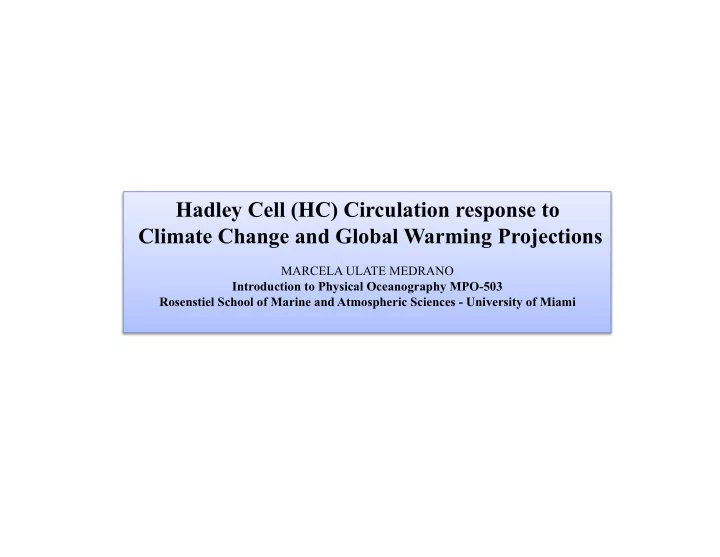

Hadley Cell (HC) Circulation response to Climate Change and Global Warming Projections MARCELA ULATE MEDRANO Introduction to Physical Oceanography MPO-503 Rosenstiel School of Marine and Atmospheric Sciences - University of Miami
Introduction and Motivation “ Tropical SSTs determine where the upward branch of the Hadley Circula:on is located over the oceans, and the dominant varia:ons in the energy transport by the Hadley cell. … Examina:on of the Hadley Circula:on in several data sets (Mitas and Clement 2005), suggest some strengthening, although discrepancies among reanalysis data sets and known deficiencies raise ques:ons about the robustness of this strengthening, especially prior to satellite era (1979).” (Trenberth et al. 2007)
Trends of the HC Overview Seasonal Cycle p ψ ( φ , p ) = 2 π a cos φ ∫ [ ] dp v ( φ , p ) g 0 g ∂ψ g ∂ψ [ ] = v [ ] = − w 2 π a 2 cos φ 2 π a cos φ ∂ p ∂φ [ ] 200 − v [ ] 850 v
Trends of the HC Change of the HC in the past years (Quan et al. 2004) NCEP/NCAR reanalysis, from January 1948 to 2000. Monthly values of wind at 17 pressure levels and at a horizontal resolution of 2.5 x 2.5 degrees. 50 year Ensemble of ECHAM-3. Simulations were forced by monthly global SSTs , the horizontal resolution of the model is 2.8 x 2.8 degrees. Global Precipitation Climatology Project (GPCP) data set with the satellite rain gauge precipitation data set.
Trends of the HC Change of the HC in the past years (Mitas and Clement 2005, 2006) NCEP/NCAR (reanalysis 1). NCEP-DOE (reanalysis 2). ECMWF – 40 year reanalysis project (ERA40). Reanalyzed observations from rawinsonde with GFDL. 15-member ensemble mean of the CAMv2.0.1 initialized by the Atmospheric Model Intercomparison Project (AMIP) SSTs. Concluded that the strength of the Hadley Cell is present in all the data sets used, but in each set the amount of increase, in terms of the stream function over time is different: Kg Kg 7.5 x 10 8 s 21.3 x 10 8 s year year
Trends of the HC Change of the HC in the past years One of the major critiques made by the scientists mentioned: Differences found between datasets, i.e NCEP-DOE (NCEP2 reanalysis) with respect to NCEP/NCAR reanalysis; Mitas and Clement 2005, 2006 found that there was a reduction up to 50% of the albedo over the tropical oceans . They proposed that this difference affects the vertical structure of the HC circulation in both cases. They also claimed the necessity of more observations in the tropics, specially over the ocean in order to monitor the behavior of the HC.
Trends of the HC Trend of HC under Global Warming Projections (Tanaka et al. 2004): Atmosphere-Ocean General Circulation Model from the Meteorological Research Institute of Japan (MRI-CGCM1), with a gradual increase in CO 2 at a rate of 1% /year during 150years. From 2000 to 2150, there is a significant change of the HC as a response to global warming, during JJA. The increase is of 40% (25 – 35 ). They proposed it is due to the change in SSTs over the ocean. According to their model outputs for the period, they found out that the change in SSTs is greater over the Atlantic than the pacific, and that this differences of temperatures result on an zonally enhancement of upward motion that causes intensification on the HC.
Trends of the HC Trend of HC under Global Warming Projections
Conclusions Some studies show evidence of the strengthening of the HC in the past years. Specially during the boreal winter (DJF). The majority of the authors agree that this change is due to the increase of the SSTs. Under global warming projections, Tanaka et al. 2004, based on model outputs, proposed the intensification of the HC up to 40% during JJA. There are not many studies in this subject; hence more investigation is needed in order to make a solid conclusion about the future behavior of the HC under global warming projections . The response HC under different climate conditions is complex and depending on the external forcing imposed. There should be an evaluation, for the reanalysis runs. In order to make the proper evaluation of the results of these reanalysis and model runs, is necessary to have a well d efined observation channel in the tropics, in the atmosphere and the ocean . Although the investigation is this subject is complicated, it is important to keep working on this matter and try to address the issues observed, specially because changes of any kind in the HC would be reflected in the earth as a whole: rain fall in the tropics (ITCZ), radiative balance, monsoon systems, ocean circulation, meridional fluxes of heat, and humidity.
Thanks
Recommend
More recommend